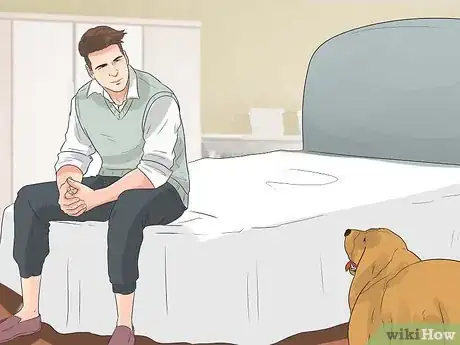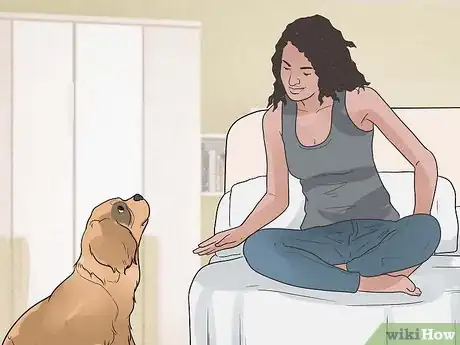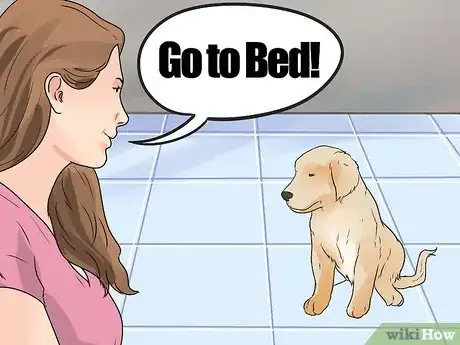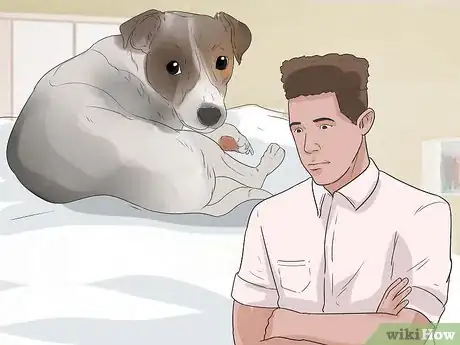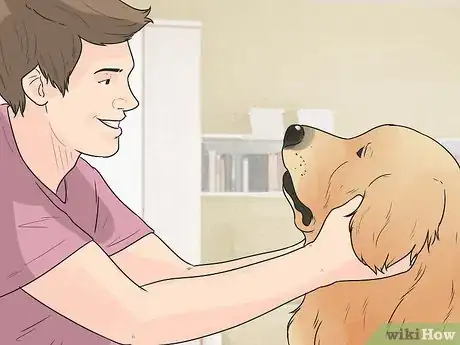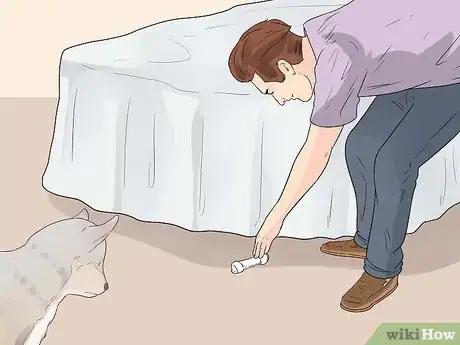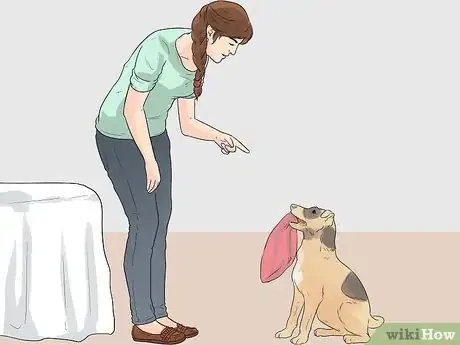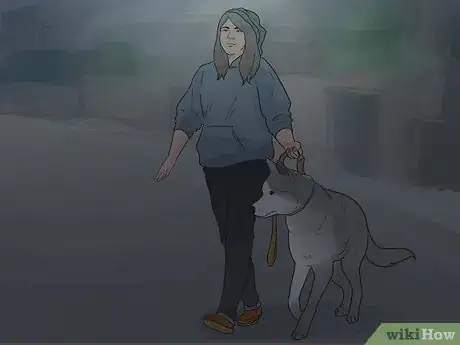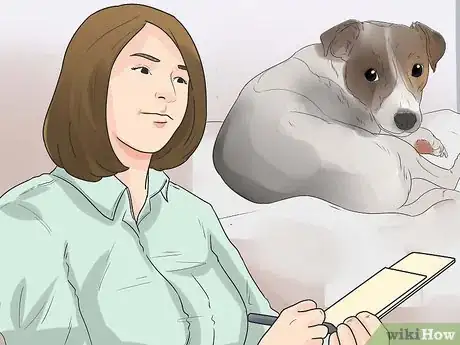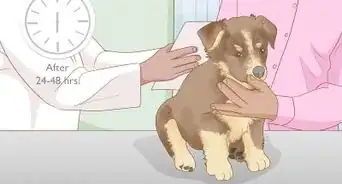This article was co-authored by Haley Yates. Haley Yates is a Dog Behavior & Training Expert and the Founder of Petra K9 Dog Training in San Jose, California. With several years of experience, she specializes in behavior modification as well as obedience training. She is an in-home dog trainer and teaches owners how to train their own dogs. She’s previously worked at several dog training facilities and taken classes to perfect her techniques.
wikiHow marks an article as reader-approved once it receives enough positive feedback. In this case, 80% of readers who voted found the article helpful, earning it our reader-approved status.
This article has been viewed 137,814 times.
Many people enjoy having their pets sleep in bed with them. It can feel comfortable and safe to sleep with your canine companion. Some dogs may be skittish about sleeping in the bed and it may take awhile to get your dog used to your sleep schedule. However, with some time you'll be sleeping with your dog each night.
Steps
Introducing Your Dog to the Bed
-
1Allow your dog to sleep in the room. Do not invite your dog into the bed with you right away. For several reasons, this is a bad idea. You need to ease your dog into sleeping in your bed. Start by letting him in your room at night.
- To start, move your dog's bed in your room. Coax him to bed with you when you go to sleep at night. Allow him to take some time getting used to your bedroom.
- Dogs can become stressed by new routines. If your dog is used to sleeping in his own bed in the living room, sleeping in your bed is a whole new behavior. This can be stressful and your dog may be hesitant at first.[1]
- Also, you need to make it clear that you're in charge. If your dog thinks the bed is his, he may become territorial about it. This could lead to him taking up too much space or whining when he can't get in the bedroom. These kinds of behaviors should not be encouraged or reinforced.[2]
-
2Reward your dog for noticing the bed. Start small. Some dogs will willingly hop on any comfortable bit of furniture. However, other dogs may be cautious about anything unfamiliar. If your dog is unsure of your bed, start with tiny rewards. If he glances at the bed, approaches it, or sniffs it, reward him.[3]
- Dogs live in the immediate. Reward the action as soon as it happens. It might be helpful to keep a small bag of treats in the bedroom. This way, you'll be able to reward your dog as soon as the behavior occurs.[4]
- There are many ways to reward a dog. Some people buy training clickers at a local pet store. When the dog behaves, they click and give him a small treat. The dog will learn that a clicking sound means he's done something right. However, if you don't want to go that route you can simply offer the dog praise when you see him noticing the bed and provide a small treat as well. Dogs tend to respond well to food as a reward.[5]
Advertisement -
3Teach your dog to wait for an invitation before jumping on the bed. If you want your dog to sleep in your bed, train him to wait for an invitation first. Dogs need a certain amount of structure. If your dog hops on and off the bed at his own desire, he may become territorial about the bed. Make sure he knows it's your bed and he's allowed on when you say so.
- Teach your dog to sit before the bed. If he starts trying to jump in the bed, say, "No" and then have him sit. Wait a few moments and then say something like, "Go to bed!" while patting the bed to signify that it's time to sleep.[6]
- Do a few training sessions each day while you're still establishing the rules. You can use positive reinforcements, like praise or treats, when your dog completes the behavior successfully.[7]
- Eventually, you'll want your dog to come sit by the bed and wait for an invitation before climbing in bed with you each night.[8]
-
4Reinforce the desired behavior with a command. It can be helpful to have a command that tells your dog it's time for bed. This can make bedtime smoother for both of you. For example, when you're ready to turn out the lights you could say something like, "Go to bed." This tells your dog it's time to hop in the bed and lie down. Each night, as you're winding down to rest, say, "Go to bed" right before you turn out the lights. You want your dog to associate this command with sleep time.[9]
-
5Be patient if you have a cautious dog. Some dogs are more skittish than others. If your dog is nervous by nature, it may take awhile to get him used to your bed. Cautious dogs are generally slower to learn new behaviors. They may need more rewards as encouragement. If you have a cautious dog, go slowly and reward often. It may take a few months to get your dog sleeping in the bed with you if he's generally nervous.[10]
Encouraging Good Behavior
-
1Provide positive reinforcement. Dogs need a lot of positive reinforcement to behave. Once your dog is comfortable in your bed, provide positive reinforcement. Each night, when your dog gets in bed with you, give him praise or a treat to show him he's behaving properly.
-
2Create positive associations with the bed. If your dog is a slow learner, it can help to create positive associations with the bed. Your dog will be more eager to join you in bed each night if he thinks of the bed as a place where happy, fun things happen.[11]
- Try feeding your dog on or near the bed. You can lay down a towel over the bed to prevent a mess.
- Put some things your dog likes in the bed with you. Allow him to have some of his toys and blankets in the bed.[12]
- Spend some time just sitting in the bed with your dog. Watch TV or read a book and allow your dog to hop up on the bed with you. Periodically pet him or praise him.
- Be careful, however, not to teach him to associate anything too disruptive with the bed. You want him to sleep through the night and not disturb you. Therefore, playing with your dog in the bed may be a bad idea.
-
3Discourage unwanted behaviors. Dogs respond well to negative reinforcement as well. Some behaviors can be disruptive to sleep.
- Dogs may not respond well to punishment or scolding. It's sometimes easier simply to ignore bad behaviors. If your dog sees he's not getting a response, he may stop. For example, if your dog is whining or barking at night, just ignore it. Yelling at him might make him feel like you're barking back, encouraging him to keep it up.[13]
- If your dog is continuing to behave poorly, taking something away is also an effective means to discourage the behavior. Sometimes dogs act out to get your attention, good or bad, and yelling may only encourage bad behavior. Instead of scolding your dog when he's being disruptive at night, consider putting him on the floor. Do not let him back into the bed until he's calmed down. Eventually, your dog will realize certain behaviors result in him being removed from the bed. He'll stop engaging in those behaviors.[14]
-
4Respect your dog's comfort zone. It's great to have your dog sleep in the bed with you. However, it should be a positive experience for you and your dog. Many owners enjoy snuggling with their pets, but some dogs may dislike being handled, especially if they're trying to sleep. If your dog growls or fidgets in response to cuddling, refrain from the behavior. Allow your dog to sleep in his own space.
Establishing a Sleep Schedule
-
1Exercise your dog around bedtime. If you share a bed with your dog, it's important he sleeps through the night. This way, you'll both get a good nights sleep. One way to encourage your dog to sleep is to exercise him a few hours before bedtime. Take your dog for a walk in the late evening. Spend some time playing with him in the living room with his favorite toy. This way, your dog won't be wired when you turn off the lights.[15]
-
2Stick to a regular sleep schedule. You are the highlight of your dog's life. He wants to be awake when you're awake and near you when you're sleeping. If you want to make sure your dog is getting enough sleep, stick to a regular sleep schedule. If you go to bed and wake up at roughly the same time each night, both you and your dog will have higher quality sleep. There will be less tossing and turning at night.[16]
-
3Take your dog out right before bedtime. Your dog may have difficulty sleeping if he needs to use the bathroom. Take your dog out right before you go to bed. If you go to bed late, you don't need to walk your dog around the block. Simply let him step out onto the sidewalk or backyard to have a quick pee. He'll be more comfortable when sleeping and more likely to fall asleep fast.[17]
-
4Leave ice cubes in your dog's bowl. Your dog may get thirsty during the night. However, drinking too much at night can put stress on his bladder. If he needs to go out, it'll be harder for him to sleep. You can put a few ice cubes in his dog bowl at night. If he gets thirsty, he can lick the ice cubes. This way, he's getting a little bit of water but not drinking enough to disrupt his sleep.[18]
Expert Q&A
Did you know you can get expert answers for this article?
Unlock expert answers by supporting wikiHow
-
QuestionIs it safe for a dog to drink cold water?
 Pippa Elliott, MRCVSDr. Elliott, BVMS, MRCVS is a veterinarian with over 30 years of experience in veterinary surgery and companion animal practice. She graduated from the University of Glasgow in 1987 with a degree in veterinary medicine and surgery. She has worked at the same animal clinic in her hometown for over 20 years.
Pippa Elliott, MRCVSDr. Elliott, BVMS, MRCVS is a veterinarian with over 30 years of experience in veterinary surgery and companion animal practice. She graduated from the University of Glasgow in 1987 with a degree in veterinary medicine and surgery. She has worked at the same animal clinic in her hometown for over 20 years.
Veterinarian
Expert Interview
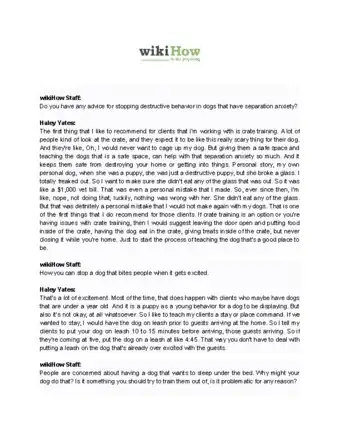
Thanks for reading our article! If you'd like to learn more about dog training, check out our in-depth interview with Haley Yates.
References
- ↑ http://www.quickanddirtytips.com/pets/dog-training/teach-your-dog-to-go-to-bed
- ↑ https://www.cesarsway.com/dog-training/crate/tips-for-doggy-sleeping-arrangements
- ↑ http://www.quickanddirtytips.com/pets/dog-training/teach-your-dog-to-go-to-bed
- ↑ http://www.quickanddirtytips.com/pets/dog-training/teach-your-dog-to-go-to-bed
- ↑ http://www.quickanddirtytips.com/pets/dog-training/teach-your-dog-to-go-to-bed
- ↑ http://www.huffingtonpost.com/robert-haussmann/letting-your-dog-sleep-in-the-bed_b_1571522.html
- ↑ http://www.huffingtonpost.com/robert-haussmann/letting-your-dog-sleep-in-the-bed_b_1571522.html
- ↑ http://www.huffingtonpost.com/robert-haussmann/letting-your-dog-sleep-in-the-bed_b_1571522.html
- ↑ http://www.quickanddirtytips.com/pets/dog-training/teach-your-dog-to-go-to-bed
- ↑ http://www.quickanddirtytips.com/pets/dog-training/teach-your-dog-to-go-to-bed
- ↑ http://www.quickanddirtytips.com/pets/dog-training/teach-your-dog-to-go-to-bed?page=1
- ↑ http://www.quickanddirtytips.com/pets/dog-training/teach-your-dog-to-go-to-bed?page=1
- ↑ https://www.cesarsway.com/dog-training/crate/tips-for-doggy-sleeping-arrangements
- ↑ http://totallydogtraining.com/what-is-negative-reinforcement-in-dog-training/
- ↑ http://www.dogsbestlife.com/home-page/help-your-dog-sleep-through-the-night/
- ↑ http://www.dogsbestlife.com/home-page/help-your-dog-sleep-through-the-night/
- ↑ http://www.dogsbestlife.com/home-page/help-your-dog-sleep-through-the-night/
- ↑ http://www.dogsbestlife.com/home-page/help-your-dog-sleep-through-the-night/
About This Article
To encourage your dog to sleep in your bed, start by letting it sleep in your room at night. Next, use praise and treats to teach your dog that it's okay to get on your bed. It may help to put a soft blanket or some of its favorite toys in the bed. Then, when your dog gets into bed with you each night, give it praise or a treat to positively reinforce the behavior. For tips on preventing your dog from getting territorial about the bed, read on!
